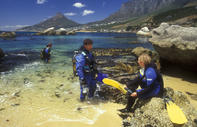This wreck lies close to shore between Sandy Bay and Vulcan Rock. The Boss 400 crane lies about 20 m from the Maori. The Maori, a 5 317 ton steamship sank on 5 August 5 1909, with a cargo of crockery and water piping.

The Maori
Average depth: 15 m
Maximum depth: 23 m
It was on its way from London to New Zealand when it was wrecked after striking a rock in thick fog. The wreck is covered in coral and this is a beautiful dive when the visibility is good. On the sea floor, there is a vast amount of scattered porcelain dating back to 1909. Nudibranchs in the most spectacular colours are found on this wreck and don’t get a fright if a curious seal swims by to have a closer look at you.
The Boss
Average depth: 20 m
Maximum depth: 25 m
This boat dive takes you to what was once the largest floating crane in Africa. While being towed during a storm, the towline broke and she drifted helplessly onto the rocks. Stuck on the rocks with most of the crane above water and big pieces of the superstructure lying around the wreck, she makes an interesting dive. This is a great 2-tank dive, as the Oakburn lies partly under the Boss 400 wreck. Plenty of fish and other marine life can be seen, with large fish often visiting this area and great whites are known to have been sighted here. This site can only be dived on calm days as it is in an exposed position.
The Oakburn
Average depth: 19 m
Maximum depth: 25 m
On 21 May 1906, the Oakburn, a 3 865 ton British Steamer hit the rocks of Maori Bay during thick fog. She was on a voyage from New York to Sydney carrying a cargo of railway equipment, sewing machines, musical instruments, glassware, oil and paper – two lives were lost. The wreck is partly broken up, but there are still sections of the bow and engine that are recognisable. Many artefacts can still be found lying around on the site. Large fish and seals can be seen along with the hard and soft corals on this wreck.
The Romelia
Average depth: 12 m
Maximum depth: 25 m
The Romelia was a Liberian oil tanker that was on route to a Taiwanese breaker’s yard together with the Antipolis. She floundered on Sunset Rocks on 29 July 29, 1977. Both ships were in tow when the cable snapped in one of Cape Town’s notorious winter storms. The ship has interesting portholes and fittings to swim and peer through. This site is cold and clear after a south-easterly wind has blown. The surge can be very strong on the southern side and there is a strong suction through a hole on the northern side of the wreck, so this site should only be dived when conditions are perfect and it is also therefore not recommended for novice divers. Dense kelp forests can be found around the Romelia and you are likely to see colourful invertebrates, Shysharks, Hottentots, Janbruins and Romans. Other small fish also like to gather in the kelp for protection, while various Starfish, anemones and urchins line the bottom of the seafloor.
Geldkis
Average depth: 12 m
Maximum depth: 22 m
Geldkis is a rock off the shore from Sandy Cove, which involves quite a swim. The dive site is on the outer side of the rock or around the blinder, which breaks a few metres out to sea from the rock. You can also just dive around the rock if you prefer – there is still plenty to see and not everybody cares to swim this far in the Atlantic’s cold water. On the rock, you can find colourful anemones and many species of Nudibranchs while crayfish can be found in the crevices. Octopus and shysharks can also be found hiding all over the reef. There is also the possibility that you will see rays and cuttlefish in this area.